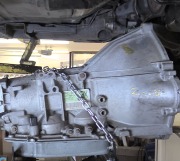Have the 3-2 solenoid tested.
COMPONENT TESTS
COMPONENT & WIRING HARNESS RESISTANCE CHECK
1. Install Jumper Harness (J-39775) to transmission 20-pin connector. Using an ohmmeter, measure resistance between specified terminals for each component. See Fig. 3. Compare resistance reading to known values. See TRANSMISSION COMPONENT RESISTANCE SPECIFICATIONS table.
2.
If resistance reading is okay, go to next step. If resistance reading is not okay, disconnect wiring harness at component and measure component resistance. Replace component if resistance is not as specified. If resistance is as specified, repair wiring harness between component and 20-pin connector.
3. Measure resistance between ground and each terminal at transmission 20-pin connector. See Fig. 3. Resistance should be more than 250 k/ohms for each solenoid and more than 10 megohms for fluid temperature sensor and vehicle speed sensor. Resistance for fluid temperature sensor will vary with temperature. If resistance is within specification, problem is intermittent. If resistance is low, disconnect wiring harness at component.
4. Measure resistance between component terminals and ground. If resistance is low, replace component. If resistance is high, inspect wiring harness for short to ground. Repair as necessary.
Images (Click to make bigger)
Saturday, December 25th, 2010 AT 9:12 AM





